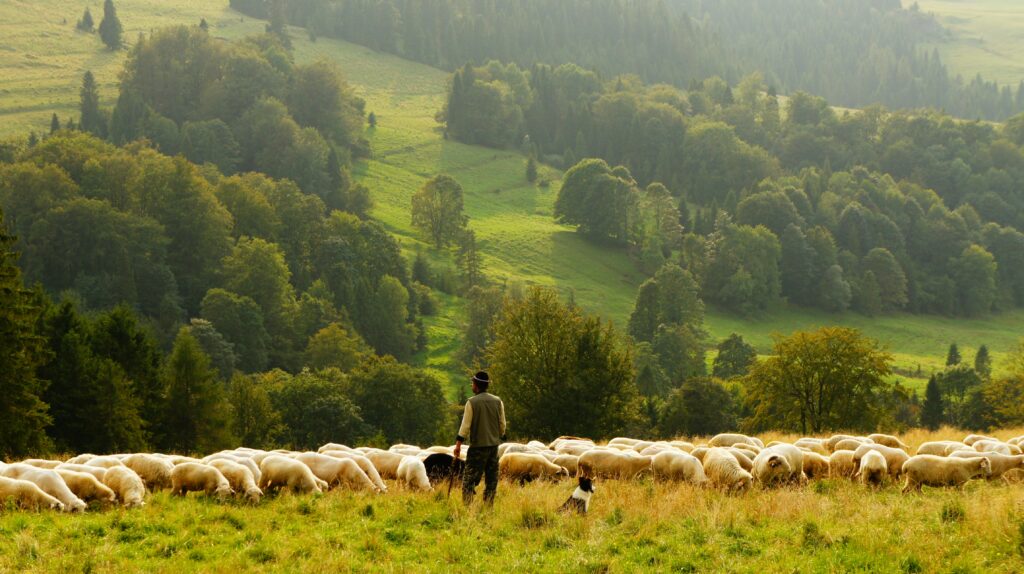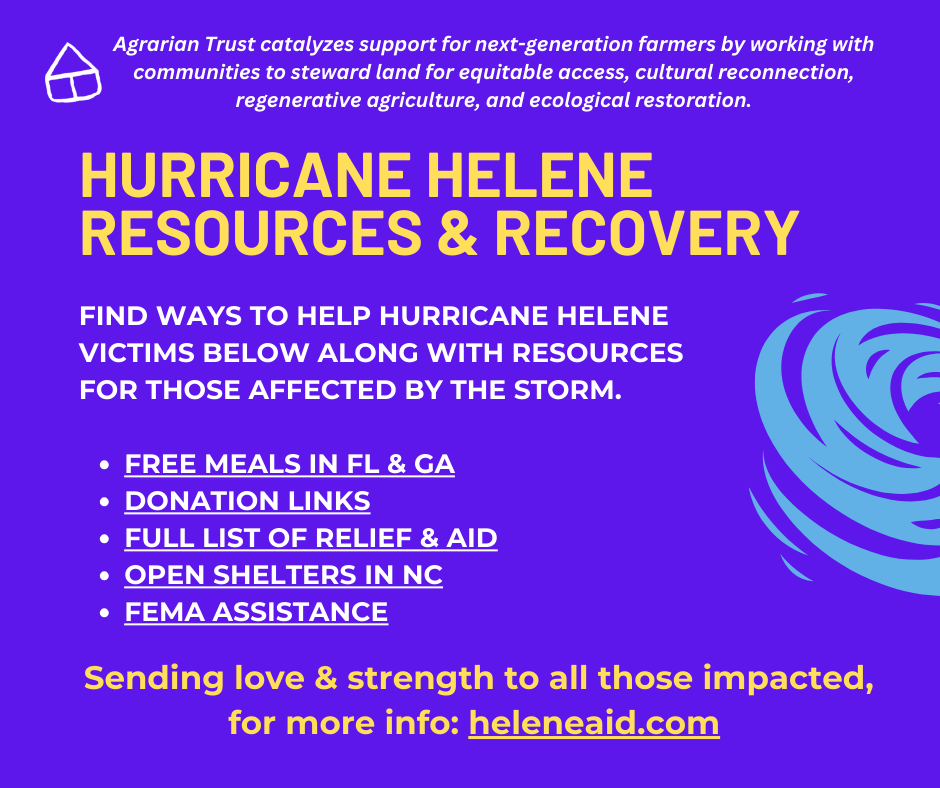
In April 1651, the political theorist Thomas Hobbes published his most well-known literary work, Leviathan. An ardent royalist writing primarily in response to the discord of the English Civil War, Hobbes reached the conclusion that, without the oversight of a patriarchal ruler, men would remain in a perpetual state of “war of all against all,” doomed to live lives that were “nasty, brutish and short.”
As the Agrarian Trust creates and expands the model of the Agrarian Commons, it is important to address mainstream misrepresentations of commoning practices.
A little over 300 years later, an ecologist by the name of Garett Hardin published an essay that would shape how academics and environmentalists alike viewed the commons for decades to come. Like Hobbes, Hardin’s view of human nature bordered on the apocalyptic. In his 1968 essay, “The Tragedy of the Commons,” Hardin paints a profoundly pessimistic, and ultimately inaccurate, view of the commons, wherein individuals relentlessly pursue their own self-interest and drain the commons of its resources. As Agrarian Trust creates and expands the model of the Agrarian Commons, it is important to address mainstream misrepresentations of commoning practices. The Agrarian Commons, along with countless commoning communities across the globe, serves as living proof that the paradigms of “war of all against all” and “the tragedy of the commons” are obsolete. Instead, Agrarian Trust affirms the traditional motto of the Swiss commons: all for one, and one for all.
The Tragedy of the Commons
Garett Hardin (1915–2003) was an ecologist, biologist, and public intellectual known for writings on overpopulation and his integration of nativism, white supremacy, and environmentalism. The Southern Poverty Law Center has since identified Hardin as a white supremacist for his involvement in anti-immigrant organizations such as Californians for Population Stabilization, the Federation for Immigration Reform, and the white-supremacist press the Social Contract. Yet despite his explicitly racist and xenophobic views, Hardin’s work continues to be canonized in the environmental movement, and is featured in The Oxford Book of Modern Science Writing and American Environmentalism, edited by Al Gore and Bill McKibben. His essay “The Tragedy of the Commons” continues to exert an outsized influence on public and academic discourse surrounding the commons.
Hardin, like Hobbes, believed that humans were inherently self-serving and destructive. Rather than seeing human nature as fluid and based on cultural or economic background, in “The Tragedy of the Commons,” Hardin constructs a universal rational subject, who seeks to maximize its pleasure in any given scenario. In the central metaphor of the essay, a herdsman considers whether to add another animal to his herd, which he feeds on a common pasture. Rather than weighing the ecological or social impact of his decision, the herdsman asks only one question: “what is the utility to me of adding one more animal to my herd?” (1244) Starting from this premise, the herdsman concludes that the benefits to himself of adding one more animal to the herd far outweigh the negative outcomes associated with overgrazing, which are diffused across the community and ecosystem.
This, in a nutshell, is the tragedy of the commons. Because Hardin’s subject is constructed as invariably rational and self-serving, Hardin concludes that he is forever doomed to make the same decision. Hardin writes, “Each man is locked into a system that compels him to increase his herd without limit, in a world that is limited. Ruin is the destination toward which all men rush, each pursuing his own best interest in a society that believes in the freedom of the commons. Freedom in a commons brings ruin to all.” (1244) If left unregulated, Hardin believed, the commons would be depleted by selfish individuals taking advantage of their unlimited access to communally owned resources.
As a solution to the tragedy of the commons, Hardin argues that the commons needed to be privatized or regulated by a third-party authority. In the first instance, it would be in individuals’ best interest to maintain the quality and sustainability of their resource pool if they owned it as private property. In the second, individuals would be deterred from exploiting the resource pool by the threat of “mutually agreed upon,” or state “coercion.” Access to the commons would be determined based on qualifications such as wealth, merit, or lottery. Because not all resources can be enclosed (air and water for example), Hardin argues for population control as a means of lowering the overall demand for what he considers a fixed pool of resources. He even goes as far as arguing against the Declaration of Human Rights, which states “any choice and decision with regard to the size of the family must rest with the family itself, and cannot be made by anyone else.” (1246)
Hardin’s response to the tragedy of the commons is not to question whether a subject which knowingly pollutes its environment and depletes its resource pool is truly rational, but to radically curtail our freedom to reproduce and to hold our land in common. Indeed, Hardin’s model of the tragedy of the commons fails to hold up to empirical data.
In Defense of Commoning
The most effective and well-known rebuttal of Hardin’s “Tragedy of the Commons” is the 1990 study of collective resource management Governing the Commons: the Evolution of Institutions for Collective Action by the Nobel prize–winning economist and pioneer of New Institutional Economics, Elinor Ostrom. In her study, Ostrom draws on a wide range of case studies to analyze how communities manage common resource pools (CPR) without the intervention of a third-party state or corporate actor. Her findings help us to respond to Hardin’s tragedy of the commons on three fronts: through the effect of cultural and economic background on decision-making, the existence of communal institutions, and the inefficiencies of third-party regulators.
First, Hardin fails to account for cultural and historical differences in how individuals interact with the commons. It doesn’t take much to see that Hardin’s herdsman is not a universal figure, but, much like himself, a white, patriarchal man cut off from values of care for the land and one another, who conflates “reason” with the unmediated pursuit of his own pleasure and wealth. In her study of commoning practices, Elinor Ostrom provides ample empirical evidence of individuals across the globe who cooperate for the benefit of their community and environment, including the fishing communities in Turkey, communal pastures in Switzerland, and irrigation communities in the Philippines and Spain. Hardin also overlooks the difference in resource consumption between individuals living in so-called developed and developing nations. For example, according to a report released in 2020 by Oxfam, the richest 10 percent of nations account for 52 percent of accumulated carbon emissions, while the poorest account for 7 percent In other words, the commons is not inhabited by a universal “rational” subject but a wide range of people, each with specific forms of cultural knowledge, institutions, and economic circumstances that determine their use of shared resources.
Second, Hardin conflates open-access resources with communally owned resources. He fails to acknowledge the existence of institutions that regulate individuals’ access to communal land. If Hardin’s herdsmen were able to communicate openly before deciding whether to expand their herd, or if they were part of an institution with a set of commonly accepted grazing practices, they may have been able to reach an agreement that was beneficial to themselves and their environment. As Ostrom points out, these kinds of institutions are found across the world, and vary widely according to the set of problems they are responding to. Whether these institutions are able to effectively manage a common-resource pool, Ostrom argues “is a difficult, time-consuming, conflict-invoking process. It is a process that requires reliable information about time and place variables as well as a broad repertoire of culturally acceptable rules.” (Ostrom, 14) In other words, these institutions develop regulatory practices over time through access to reliable information and in response to the problems faced by the community.
Hardin’s herdsman, on the other hand, has unregulated and limitless access to what we might call passive, “open-access” resources. In Stop Thief: the Commons, Enclosures and Resistance, historian Peter Linebaugh argues that the commons are better understood as an active force, or as the verb “commoning,” rather than a static, common-resource pool. Commoning implies that the commons exist primarily as social institutions that actively come into existence as commoners cooperatively problem-solve and negotiate resource usage among themselves. By this definition, the grazing land exploited by Hardin’s herdsman cannot be identified as a genuine commons.
Third, Hardin’s bid for a third-party regulator and the privatization of the commons fails to account for the importance of local knowledge in effectively managing a commons. As Ostrom points out, models like Hardin’s assume that an external “Leviathan” is necessary in regulating resource usage in a commons, but fail to account for the cost of maintaining this external power or the cost of enclosure (fences, enforcement of private property rights). (10) Relying on a third party to enforce private property rights can be immensely costly; consider, for example, the metastization of prisons and police department budgets in the United States. Maintaining a bureaucracy for managing resources can be similarly costly. As Sylvia Federici points out in Re-enchanting the World: Feminism and the Politics of the Commons, capitalist “third parties” such as the World Bank or International Monetary Fund lack the knowledge accumulated by commoners over the course of generations, and tend to favor extractivist policies that emphasize GDP growth over sustainability and human well-being.
It is worth noting here that the commons were humans’ primary form of land tenure for thousands of years; it is only in the past 500 years, with the rapid expansion of private property and capitalism, that Earth is being destroyed.
All for One: Reclaiming the Commons
Agrarian Trust aims to reclaim the commons and restore it to its rightful place at the center of human relations with one another and the land. “The tragedy of the commons” and the view of human nature is a defunct theoretical proposition, proven false by the countless examples of communal land tenure documented by thinkers such as Federici and Ostrom, and the practical work of community and land-based organizations. Agrarian Trust is part of a global movement of organizations, communities, and institutions dedicated to restoring communal land tenure, by advocating for the value of local knowledge, the importance of local decision-making, and the existential promise of care for the land.
Agrarian Trust believes in the ability of communities to cooperatively manage farmland, while increasing soil health, protecting watersheds, and developing strong local communities.
Agrarian Trust believes in the ability of communities to cooperatively manage farmland, while increasing soil health, protecting watersheds, and developing strong local communities. The Agrarian Commons model is a concrete response to the problems faced by farmers in the United States. By placing control of the land in the hands of the farmers who farm it, and in the community who benefits from it, the model seeks to counteract the rapid accumulation of farmland in the hands of a few absentee owners and factory farms, while reaffirming the importance of local control of the land. By giving 99-year leases to farmers, the model ensures that farmers can develop an intimate knowledge of their land, build soil, increase biodiversity, and plan for the long-term health of the land. Furthermore, the Agrarian Commons model prioritizes land and communities that have been subject to extraction and exploitation, and actively works to acknowledge Indigenous sovereignty over the land. The Agrarian Commons seeks to begin to address the harm caused by over five centuries of settler colonialism and capitalist enclosure, and to create an agricultural commons that respects local government, Indigenous knowledge, and the health of the land.
The Agrarian Commons is not the only solution, but one step forward out of the private property commoditized capitalist framework toward a complex and resilient commons that will serve as an alternative to the rampant ecological destruction and exploitation of neoliberal capitalism.
Listen to executive director Ian McSweeney and Agrarian Trust founder Severine von Tscharner Fleming discuss the Agrarian Commons on the Frontiers of Commoning Podcast: https://david-bollier.simplecast.com/episodes/agrarian-trust-with-severine-von-tscharner-fleming-ian-mcsweeney




